Veeam Backup (EE)
The OpenNebula-Veeam® Backup Integration works by exposing a native oVirt-compatible REST API via the ovirtAPI server component, allowing Veeam to connect to OpenNebula as if it were an oVirt/RHV hypervisor. This integration enables Veeam to perform image-level backups, incremental backups by using Changed Block Tracking, as well as granular restores like Full VM and file-level directly from the Veeam console. This integration is part of OpenNebula Enterprise Edition (EE).
Features
Area | Benefit | Description |
|---|---|---|
Data Protection | Agentless, Image-Level Backups | Protect entire VMs without installing or managing agents inside the guest OS. |
Efficiency | Incremental Backups (CBT) | Leverages Change Block Tracking (CBT) via the API to back up only the data that has changed, reducing backup windows. |
Native Integration | Uses Standard Veeam Workflow | Connect OpenNebula as a standard "oVirt" hypervisor in Veeam. No additional custom Veeam plug-ins are required. |
Recovery | Flexible Restore Options | Enables Full VM restores, instant VM recovery, and file-level restores directly from the Veeam B&R console. |
Automation | Full Discovery | Veeam automatically discovers and displays the OpenNebula cluster hierarchy (clusters, hosts, VMs, and storage). |
Compatibility
The oVirtAPI module is compatible with the Veeam Backup & Replication version specified in the Platform Notes.
The following table summarizes the supported backup modes for each storage system:
Storage | Full | Incremental | ||
|---|---|---|---|---|
Live | Power off | Live | Power off | |
File* (qcow2) | Yes | Yes | Yes | Yes |
File* (raw) | Yes | Yes | No | No |
Ceph | Yes | Yes | No | No |
LVM | Yes | Yes | Yes** | Yes** |
* Any datastore based on files with the given format, i.e., NFS/SAN or Local.
** Supported for LVM-thin environments.
Limitations
Here is a list of the known issues and limitations affecting the Veeam integration with OpenNebula:
- Setting the
PassengerMaxPoolSizevariable to values higher than 1 can trigger issues depending on the system properties of the backup server and the amount of concurrent transfers, showing an error in the Veeam Backup & Replication console. If this happens too frequently, reduce the amount of concurrent Passenger processes to 1 until this issue is fixed. - The KVM appliance in step 4.2 does not include context packages. This implies that in order to configure the networking of an appliance, you must either manually choose the first available free IP in the management network or set up a DHCP service router.
- There is an identified bug with Ceph image datastores that avoids the opennebula-ovirtapi package from uploading images into these kind of datastores, making restores and appliance deployments fail.
- If a virtual network is owned by a user other than oneadmin (or the user chosen as the Veeam administrator in step 4.1) you may face an error when listing available networks.
- Alphine virtual machines cannot be backed up.
- During image transfers, you may see a warning message stating
Unable to use transfer URL for image transfer: Switched to proxy URL. Backup performance may be affected. This is expected and shouldn’t affect performance. - Spaces are not allowed in Virtual Machine names in the integration, so avoid using them (even if they are allowed in OpenNebula itself), otherwise you may face issues when performing an in-place restores of said VMs.
- Veeam may send multiple login token requests, which can cause to reach the OpenNebula token limit, causing backup failures if an backup was being performed when the token limit was reached.
- Incremental backups may fail for VMs with more than 1 disk attached to them.
- The number of VCPU in the KVM appliance may be set to 1 regardless of the configuration in Veeam. This can be solved by manually changing the number of vCPU in OpenNebula and restarting the VM.
Architecture
To ensure a compatible integration between OpenNebula and Veeam Backup, the following components and network configuration are required:
- Backup Server: to host both the OpenNebula Backup datastore and the OpenNebula oVirtAPI Server.
- Veeam Backup Appliance: this is automatically deployed by Veeam when OpenNebula is added as a hypervisor.
- Management Network: to provide connectivity between all of the following components:
- OpenNebula Front-end
- OpenNebula Backup server
- All OpenNebula Hosts (running the VMs to be backed up)
- Veeam Server
- Veeam Backup appliance
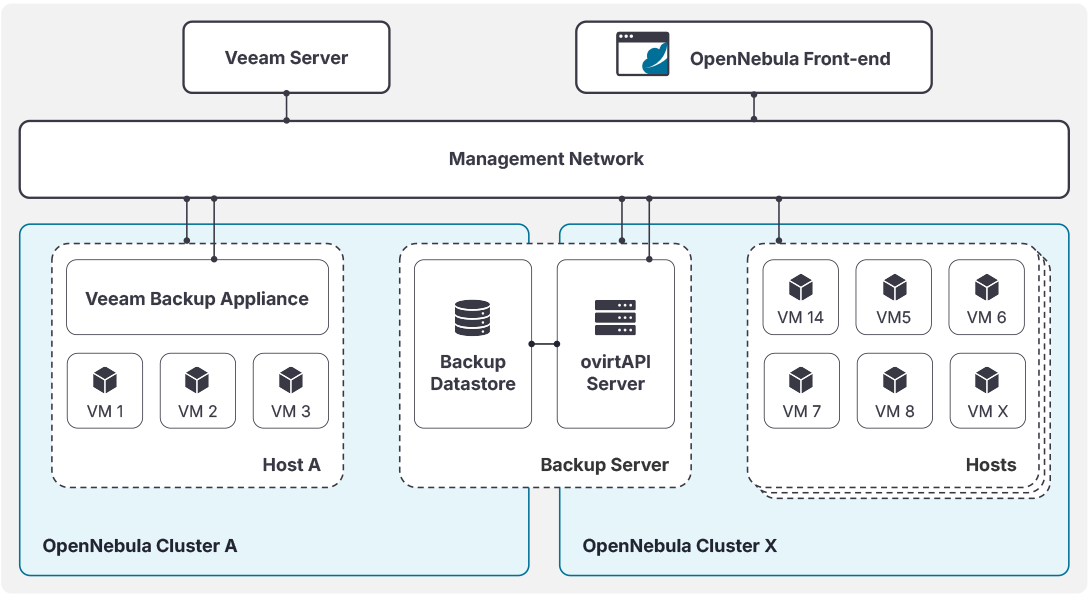
Backup Server Requirements
To ensure full compatibility with the ovirtAPI module, the Backup Server must run one of the following operating systems:
- AlmaLinux 8 or 9
- Ubuntu 22.04 or 24.04
- RHEL 8 or 9
- Debian 11 or 12
The recommended hardware specifications are:
- CPU: 4 cores
- Memory: 16 GB RAM
- Disk: Sufficient storage to hold all active backups. This server acts as a staging area to transfer backups from OpenNebula to the Veeam repository, so its disk must be large enough to accommodate the total size of these backups.
Veeam Backup Appliance Requirements
When adding OpenNebula as a platform into Veeam, a KVM appliance will be deployed (step 4.2) as a VM into OpenNebula. This appliance has the following requirements:
- CPU: 6 cores
- Memory: 6 GB RAM
- Disk: 100 GB
Please make sure that there is an OpenNebula host with enough capacity for this appliance. The system and image datastores should also be able to accomodate the disk storage requirement.
Installation and Configuration
- Prepare the environment for the oVirtAPI Server
A server should be configured to expose both the Rsync Backup datastore and the oVirtAPI Server. This server should be accessible from all the clusters that you want to be able to back up via the management network shown in the architecture diagram. The oVirtAPI Server is going to act as the communication gateway between Veeam and OpenNebula.
- Create a backup datastore
The next step is to create a backup datastore in OpenNebula. This datastore will be used by the oVirtAPI module to handle the backup of the Virtual Machines before sending the backup data to Veeam. Currently only Rsync Datastore is supported. An additional property called VEEAM_DS must exist in the backup datastore template and be set to YES.
 Remember
Remember
The backup datastore must be created in the backup server configured in step 1. Also, remember to add this datastore to any cluster that you want to be able to back up.Rsync Datastore
Here is an example of how to create an Rsync datastore in a Host named backup-host and then add it to a given cluster:
# Create the Rsync backup datastore
cat << EOF > /tmp/rsync-datastore.txt
NAME="VeeamDS"
DS_MAD="rsync"
TM_MAD="-"
TYPE="BACKUP_DS"
VEEAM_DS="YES"
RESTIC_COMPRESSION="-"
RESTRICTED_DIRS="/"
RSYNC_HOST="localhost"
RSYNC_USER="oneadmin"
SAFE_DIRS="/var/tmp"
EOF
onedatastore create /tmp/rsync-datastore.txt
# Add the datastore to the cluster with "onecluster adddatastore <cluster-name> <datastore-name>"
onecluster adddatastore somecluster VeeamDS
 SELinux/AppArmor issues
SELinux/AppArmor issues
SELinux and AppArmor may cause some issues in the backup server if not configured properly. Either disable them or make sure to whitelist the datastore directories (/var/lib/one/datastores).You can find more details regarding the Rsync datastore in Backup Datastore: Rsync.
Sizing recommendations
The backup datastore needs to have enough space to hold the disks of the VMs that are going to be backed up. This introduces a layer of redundancy to the backups, as they will be stored in the OpenNebula Backup datastore and the Veeam Backup storage. This is something inherent to the Veeam integration with oVirt, as further backups of a Virtual Machine will be incremental and only the changed disk regions will be retrieved.
If storage becomes a constraint, we recommend cleaning up the OpenNebula Backup datastore regularly in order to minimize the storage requirement, but keep in mind that this will reset the backup chain and force Veeam to perform a full backup and download the entire image during the next backup job.
We provide alongside the ovirtapi package the /usr/lib/one/ovirtapi-server/scripts/backup_clean.rb script to aid in cleaning up the backup datastore. This script can be set up as a cronjob in the backup server with the oneadmin user. The following crontab example will run the script every day at 12:00 am and delete the oldest images until the backup datastore is under 50% capacity:
0 0 * * * ONE_AUTH="oneadmin:oneadmin" MAX_USED_PERCENTAGE="50" /path/to/your/script.sh
 Remember
Remember
For the /usr/lib/one/ovirtapi-server/scripts/backup_clean.rb script to work you need to set the ONE_AUTH environment variable to a valid user:password pair that can delete the backup images. You may also set the MAX_USED_PERCENTAGE variable to a different threshold (set to 50% by default).- Install and configure the oVirtAPI module
In order to install the oVirtAPI module, you need to have the OpenNebula repository configured in the backup server. You can do so by following the instructions in OpenNebula Repositories. Then, install the opennebula-ovirtapi package.
The configuration file can be found at /etc/one/ovirtapi-server.yml. You should change the following variables before starting the service:
one_xmlrpc: Address of the OpenNebula Front-end. Please do not include any prefixes such ashttp://, only the IP address itself is needed.endpoint_port: Port used by the OpenNebula RPC endpoint (defaults to 2633).public_ip: Address that Veeam is going to use to communicate with the ovirtapi server.
 Important
Important
You may see the 5554 port in the public_ip variable in the default settings, this is no longer needed so avoid using it. Leave only the IP address in the variable, no port needed.
You may also have a variable named instance_id, which you should delete if you are running a version of the package >=7.0.1.
During installation a self-signed certificate is generated at /etc/one/ovirtapi-ssl.crt for encryption. You can replace this certificate with your own and change the cert_path configuration variable.
After installing the package, you should make sure that the oneadmin user in the backup server can perform passwordless ssh towards the oneadmin user in the Front-end server.
Finally, start the service with either systemctl start apache2 (Ubuntu/Debian) or systemctl start httpd (RHEL/Alma).
 Important
Important
Once the package is installed, a oneadmin user will be created. Please make sure that this user and the same oneadmin user in the frontend can establish passwordless ssh connections in both directions. Package dependency
Package dependency
In RHEL and Alma environments, you may face issues with the passenger package dependencies (mod_passenger and mod_ssl). You may add the correct repository and install the packages with the following:
curl --fail -sSLo /etc/yum.repos.d/passenger.repo https://oss-binaries.phusionpassenger.com/yum/definitions/el-passenger.repo
dnf install -y passenger mod_passenger mod_ssl
Performance Improvements
To increase the performance of the oVirtAPI module, you may want to modify the ammount of processes assigned to it to better utilize the CPUs available in the backup server. To do so, modify the PassengerMaxPoolSize parameters in the Apache configuration file to match the available CPUs. Depending on your distro it can be located in the following directories:
- Debian/Ubuntu:
/etc/apache2/sites-available/ovirtapi-server.conf - Alma/RHEL:
/etc/httpd/conf.d/ovirtapi-server.conf
After performing changes, restart the httpd or apache service.
- Add OpenNebula to Veeam
To add OpenNebula as a hypervisor to Veeam, configure it as an oVirt KVM Manager in Veeam and choose the IP address of the oVirtAPI module. You can follow the official Veeam documentation for this step or follow the next steps:
4.1 Add the new virtualization manager
The first step should be to add the ovirtAPI Backup server to Veeam. Head over to Backup Infrastructure, then to Managed Servers, and then click Add Manager:
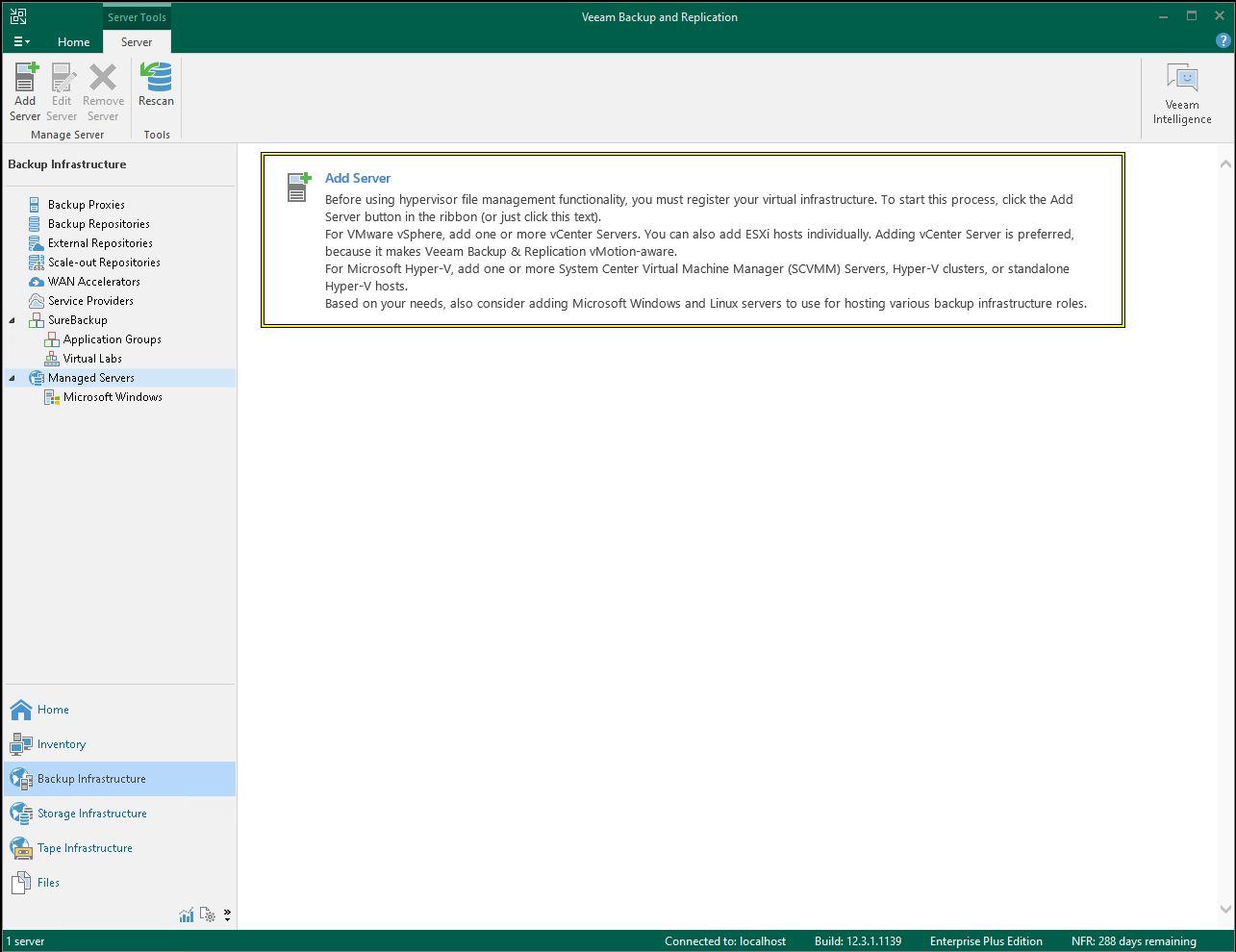
Then, choose to add a new Virtualization Platform and select Oracle Linux Virtualization Manager:
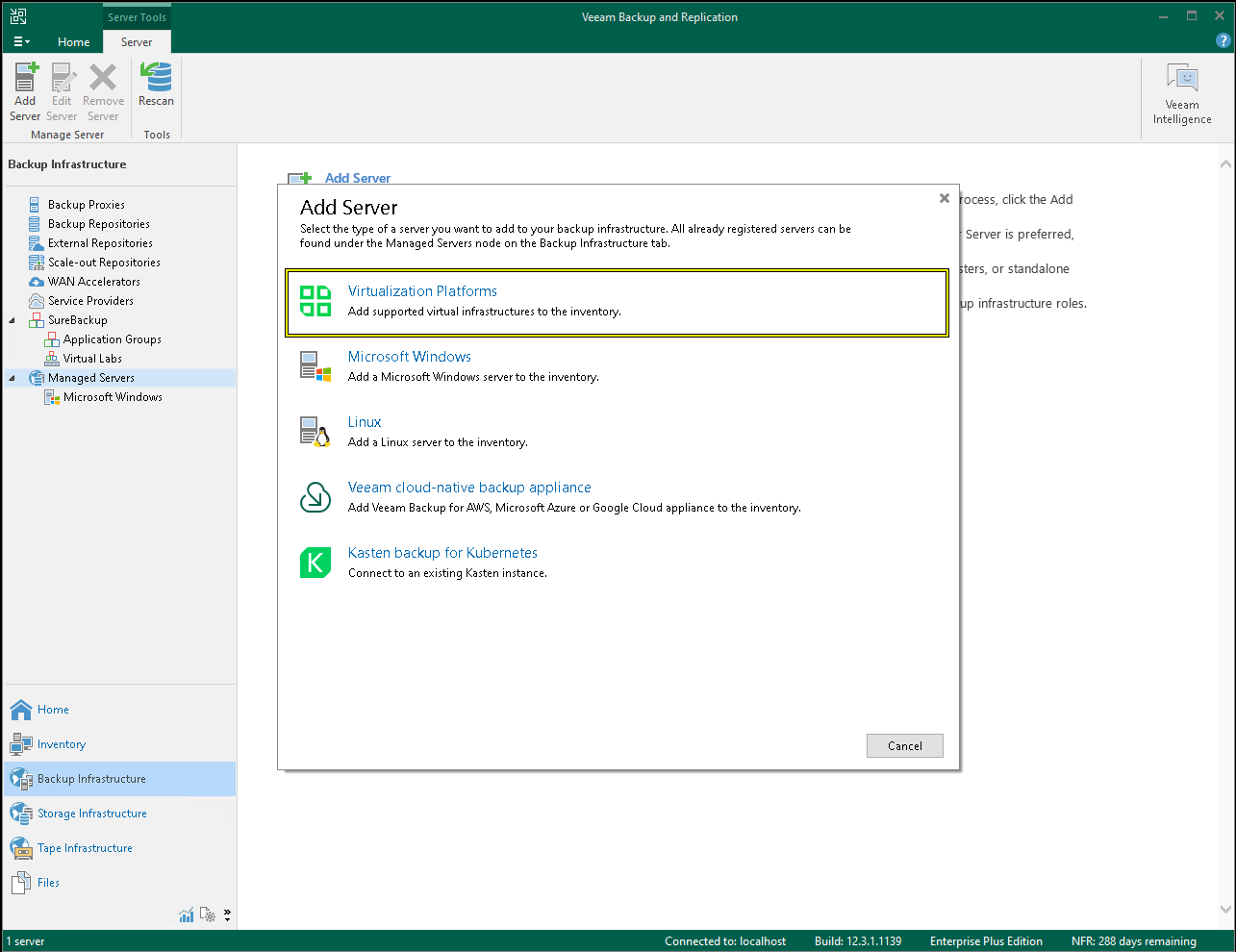
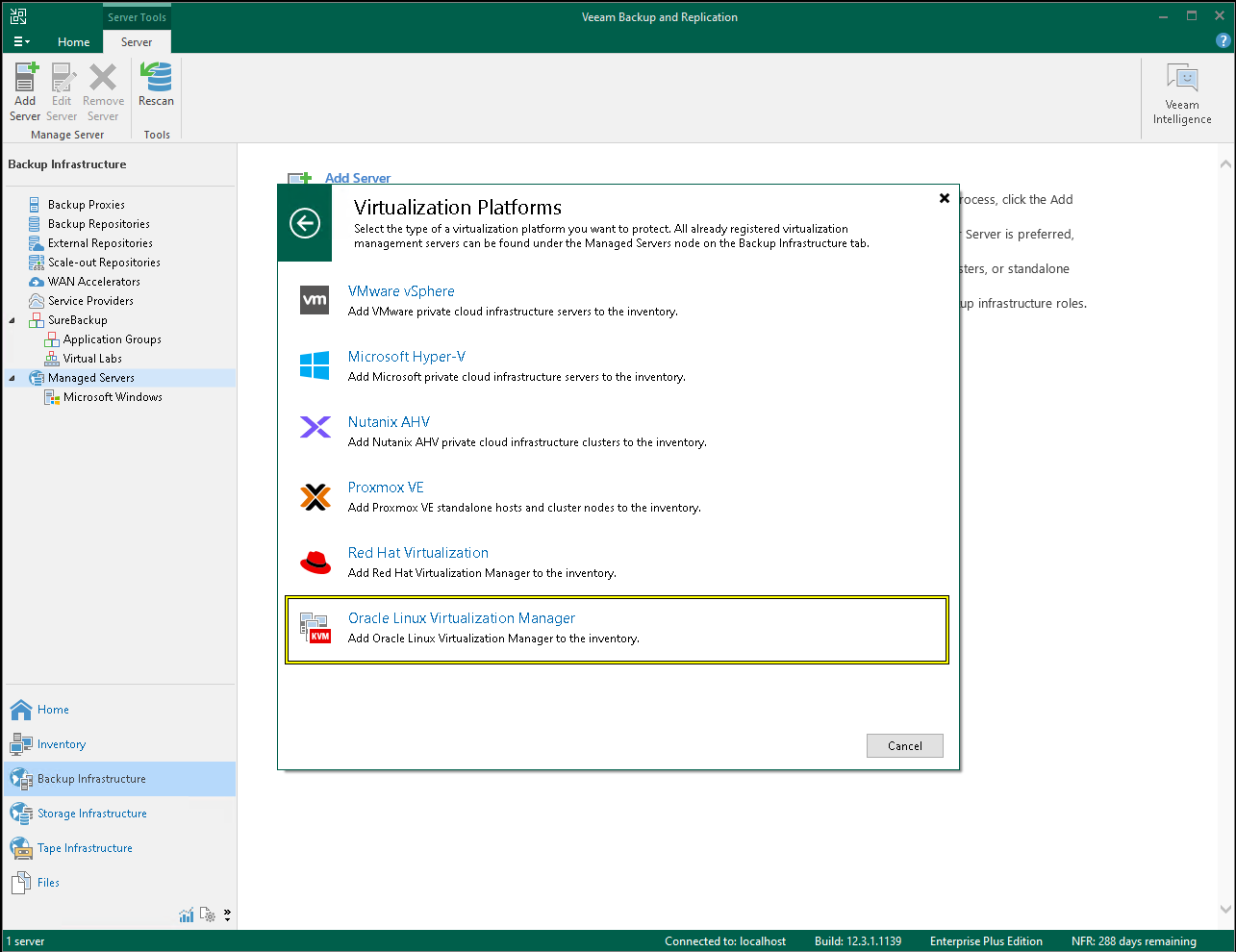
This will open a new dialog box. In the address field, you must make sure that it points to the IP address or DNS name of the server where the ovirtAPI module is installed and the backup datastore is hosted:
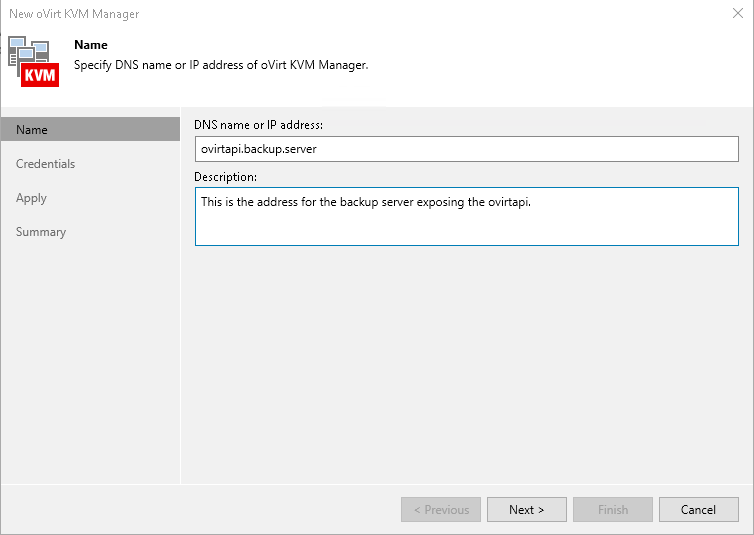
On the Credentials tab, you should set the user and password used to access the OpenNebula Front-end. You can either choose the oneadmin user or create a new user with the same privileges as oneadmin. Please remember that this user is an OpenNebula user, NOT a system user, meaning that this is a user such as the ones used to access the OpenNebula Fireedge web interface, which should be listed in the System/Users tab of Fireedge or through the CLI with oneuser list.
If you are using the default certificate, you may receive an untrust certificate warning, which you can disregard:
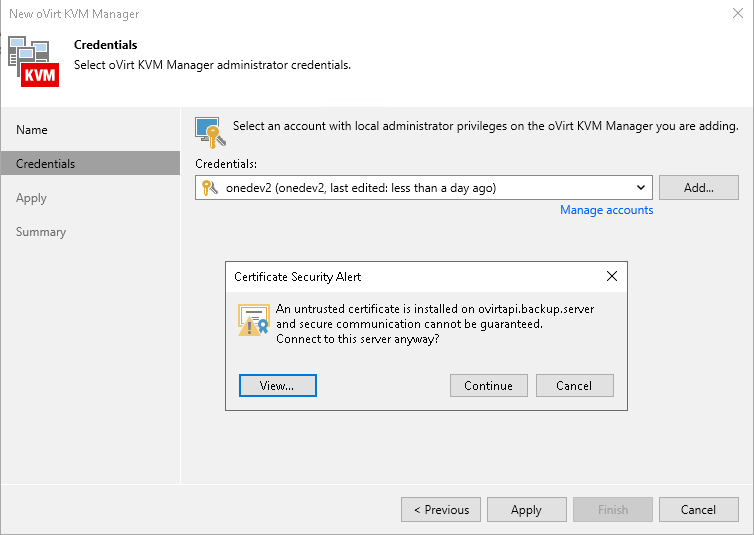
As a last step, you can click finish and the new ovirtAPI server should be listed under Managed Servers as a oVirt KVMhypervisor.
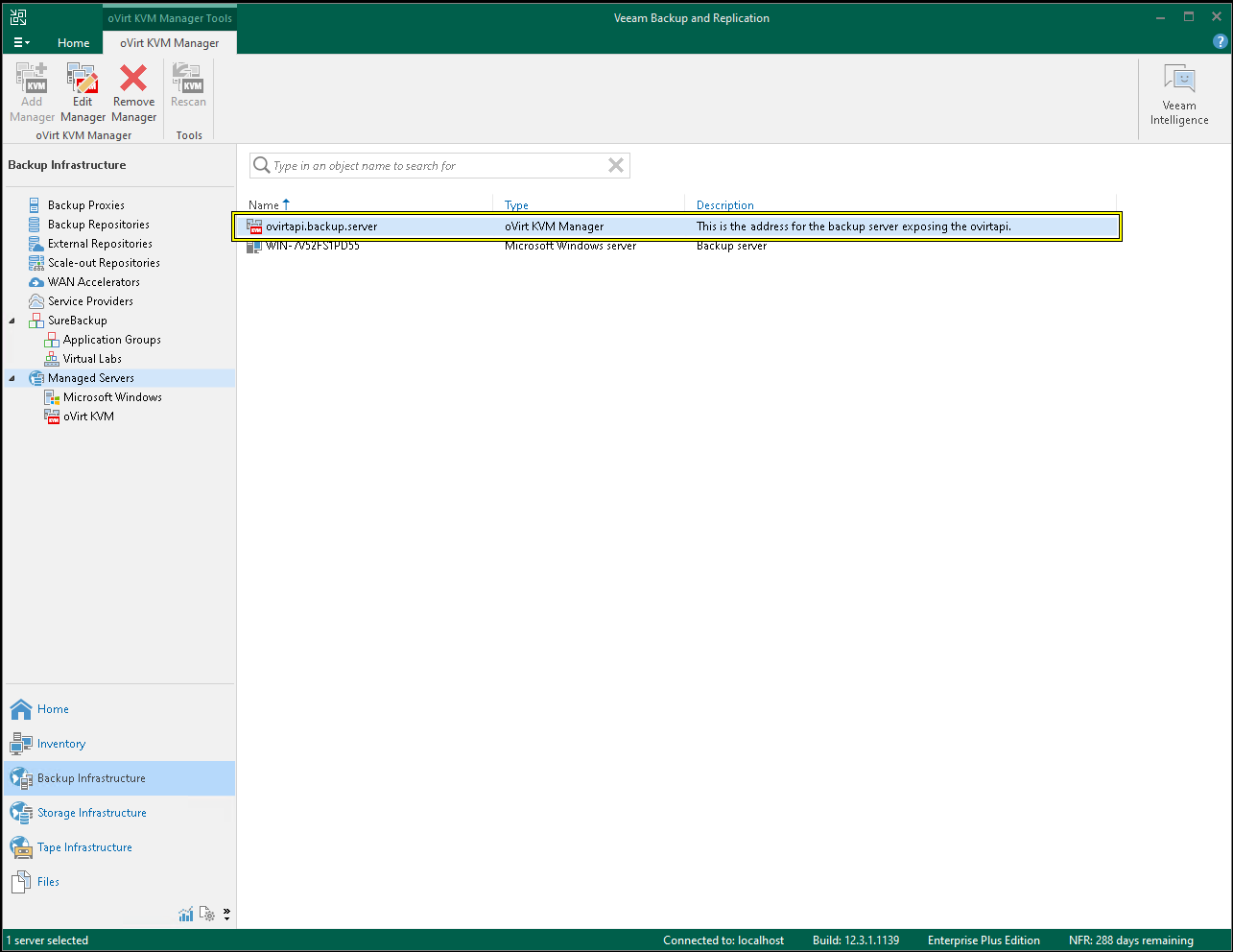
4.2 Deploy the KVM appliance
In order for Veeam to be able to perform backup and restore operations, it must deploy a dedicated Virtual Machine to act as a worker. To deploy it, go to the Backup Infrastructure tab, then Backup Proxies, and click Add Proxy:
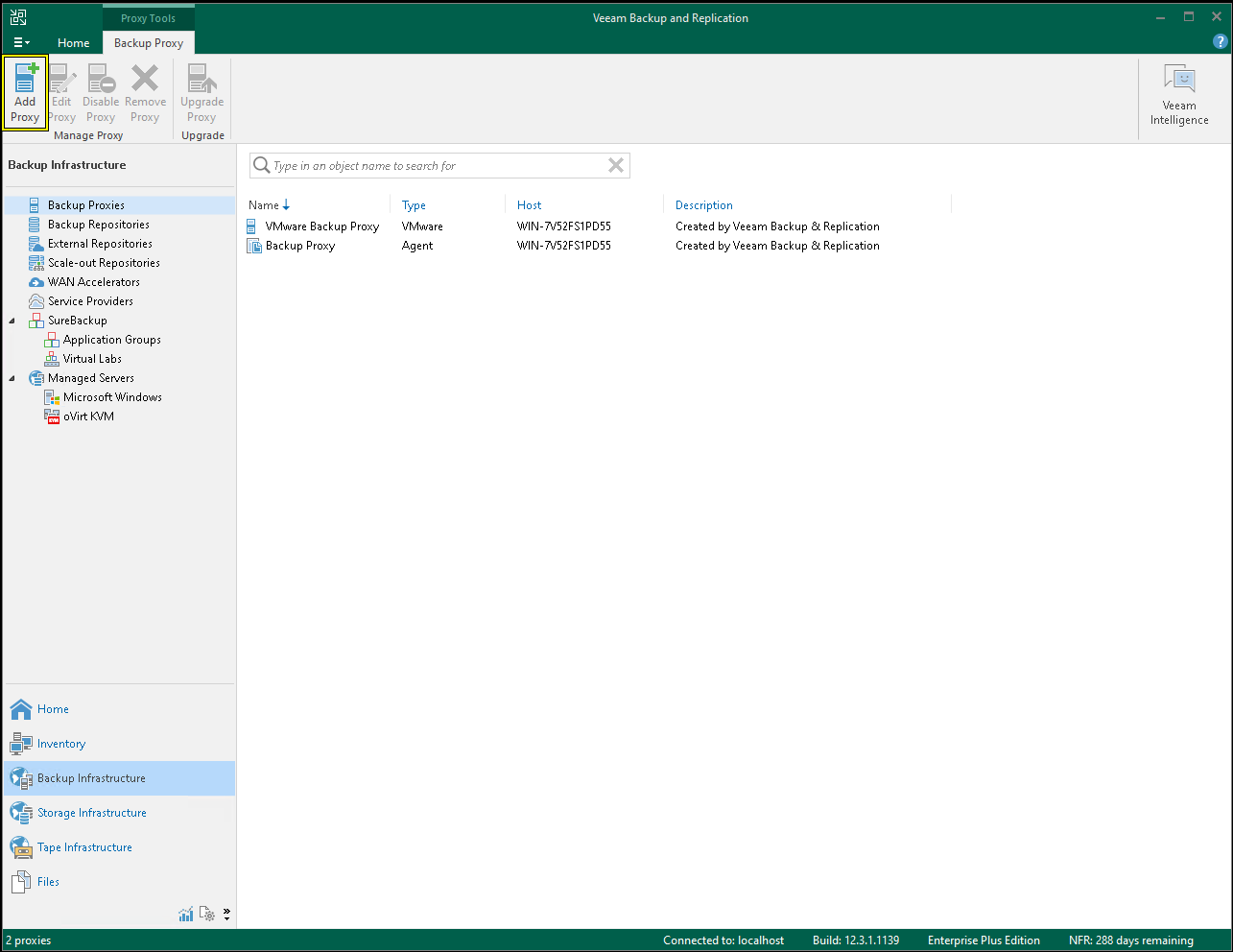
A new dialog box will open. Select the Oracle Linux Virtualization Manager, then click to deploy the Oracle Linux Virtualization Manager backup appliance:
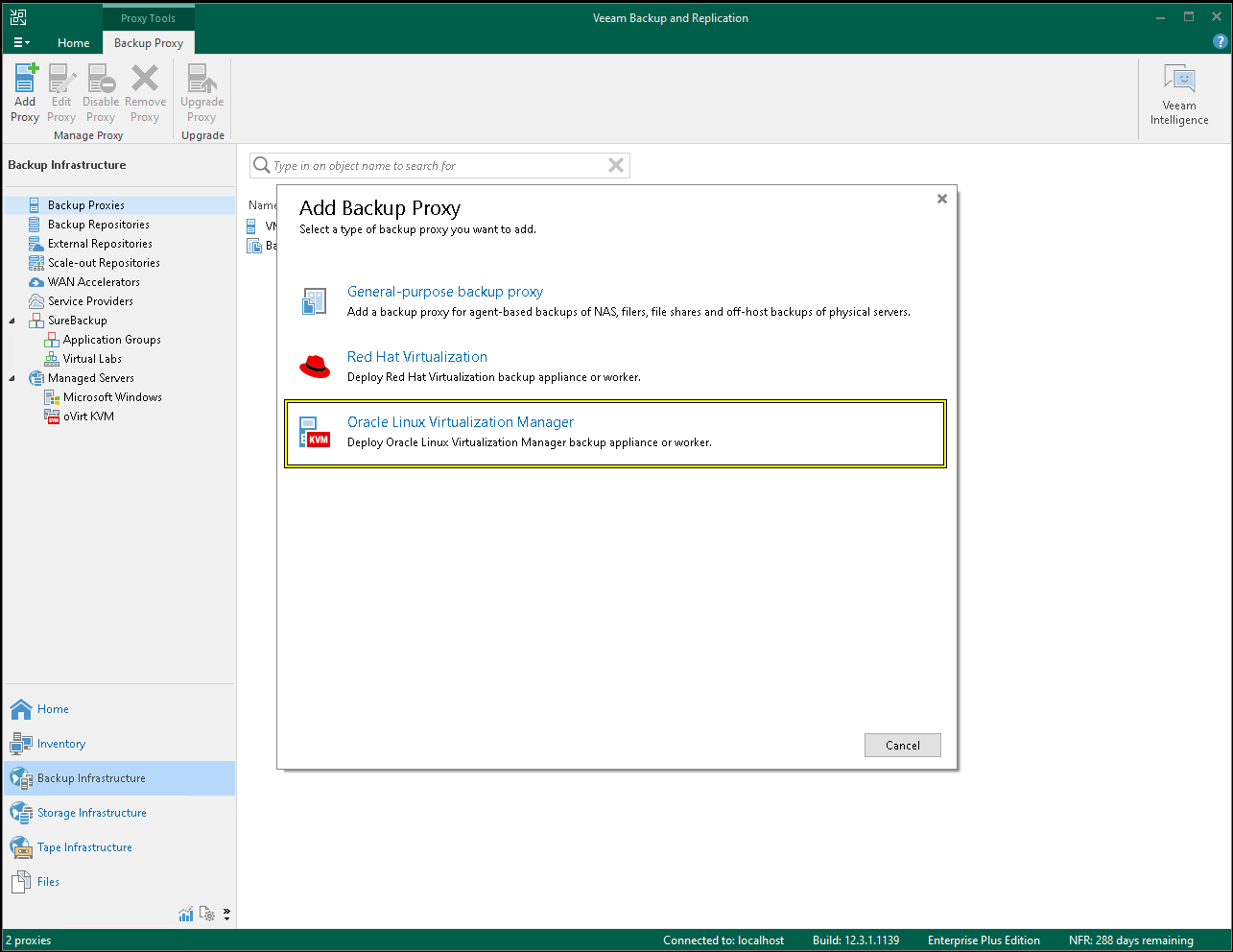
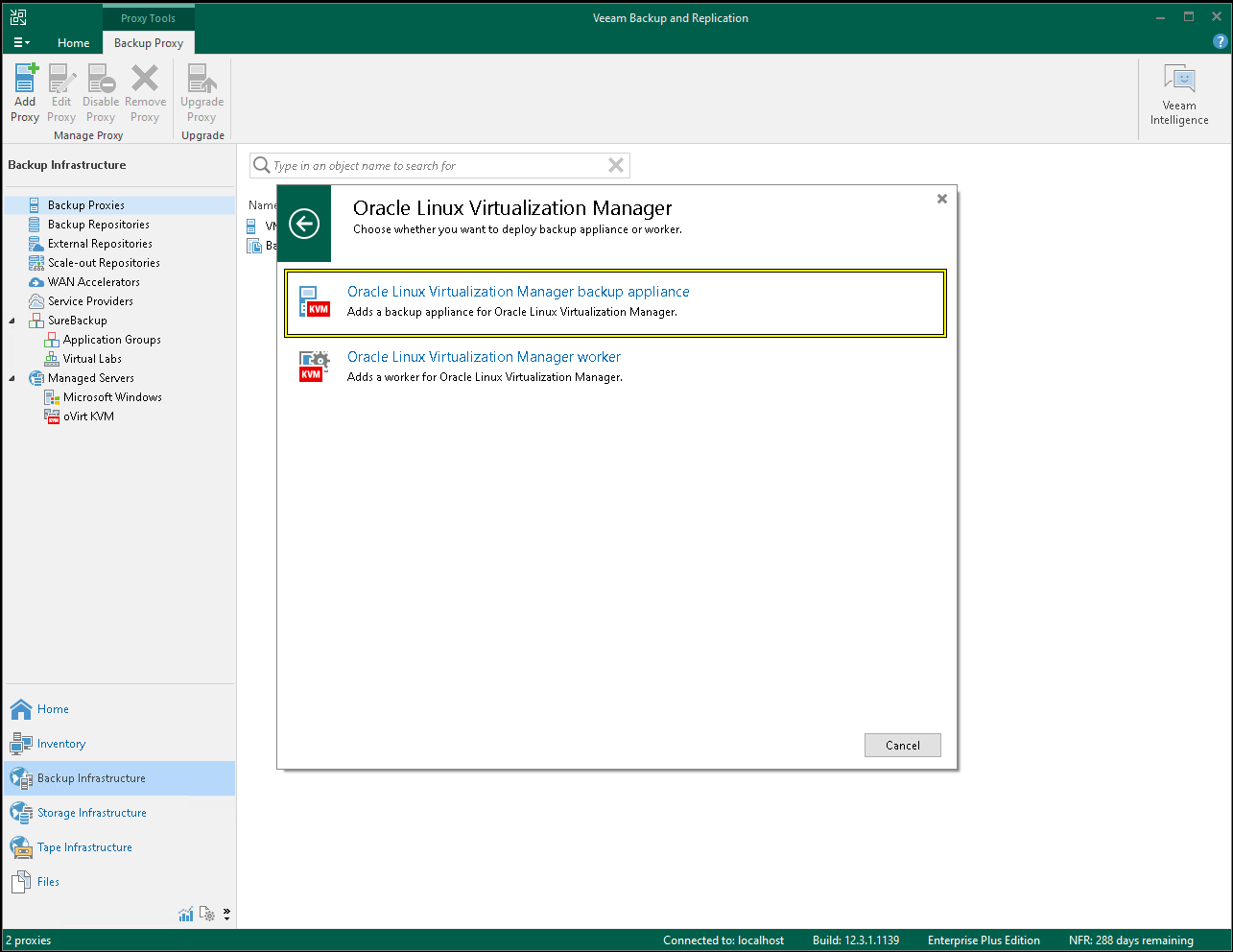
This will open a new wizard to deploy the appliance. You should choose to deploy a new appliance:
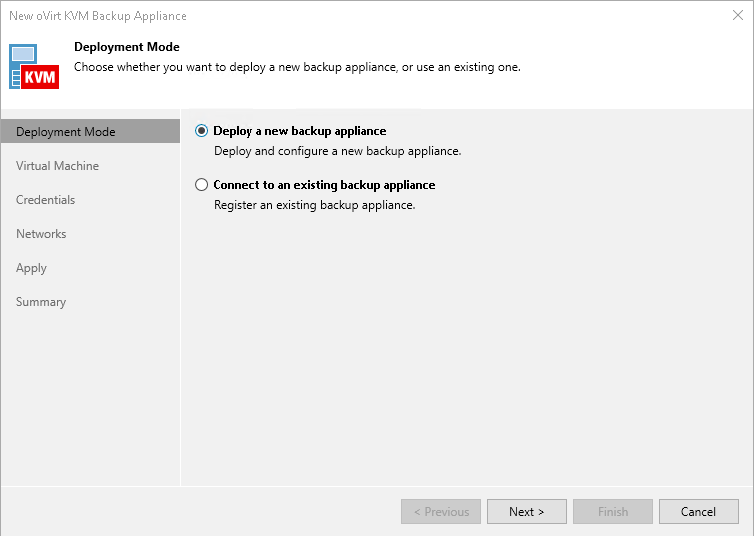
Next you should choose the cluster on which to deploy the appliance, as well as a name and the storage domain where the appliance image should be stored:
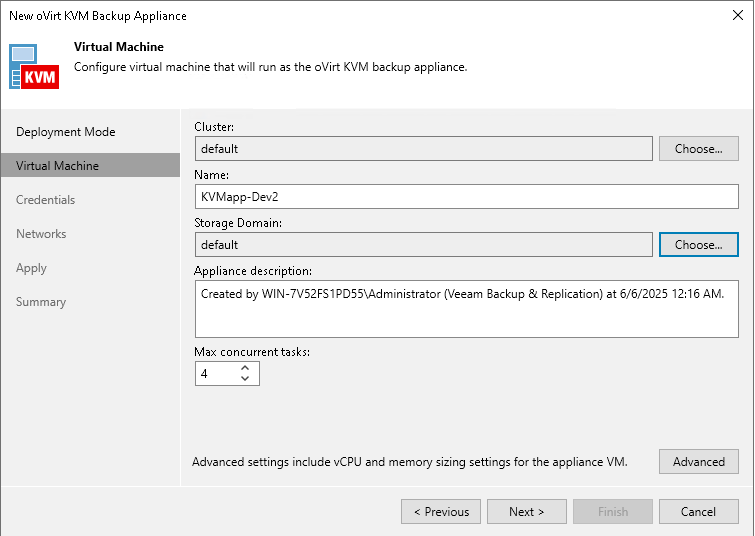
For the appliance credentials, you should choose the same ones that you set up when configuring the virtualization manager in the previous steps:
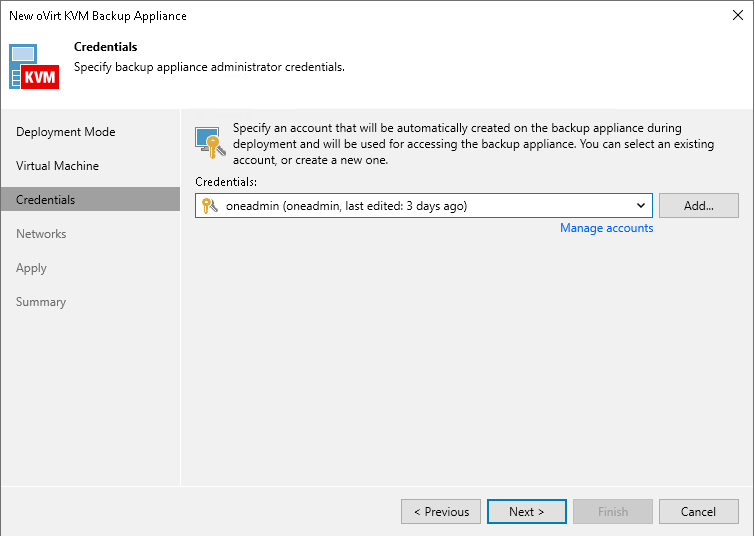
In the Network Settings tab, choose the management network that the appliance will use. It is recommended to manually choose the IP address configuration that the appliance will use. If no DHCP service is setup, use the first available free IP in the range of the management network.
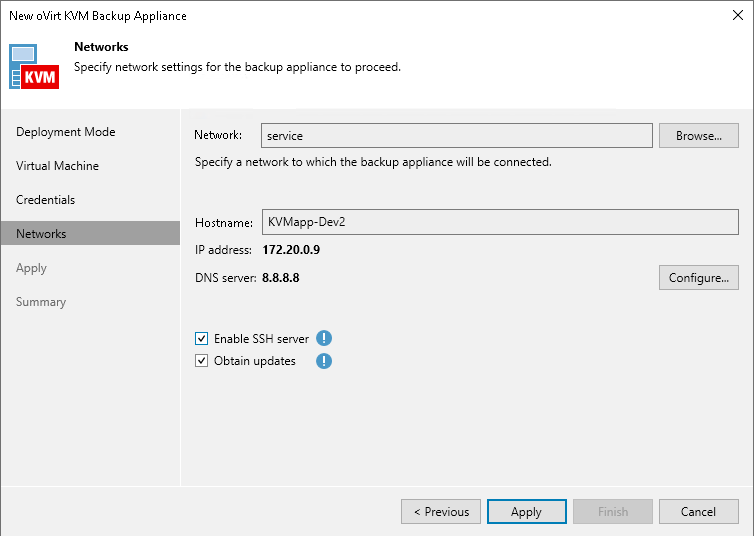
In the next step, Veeam will take care of deploying the appliance. Once finished, you should see it listed in the same tab:
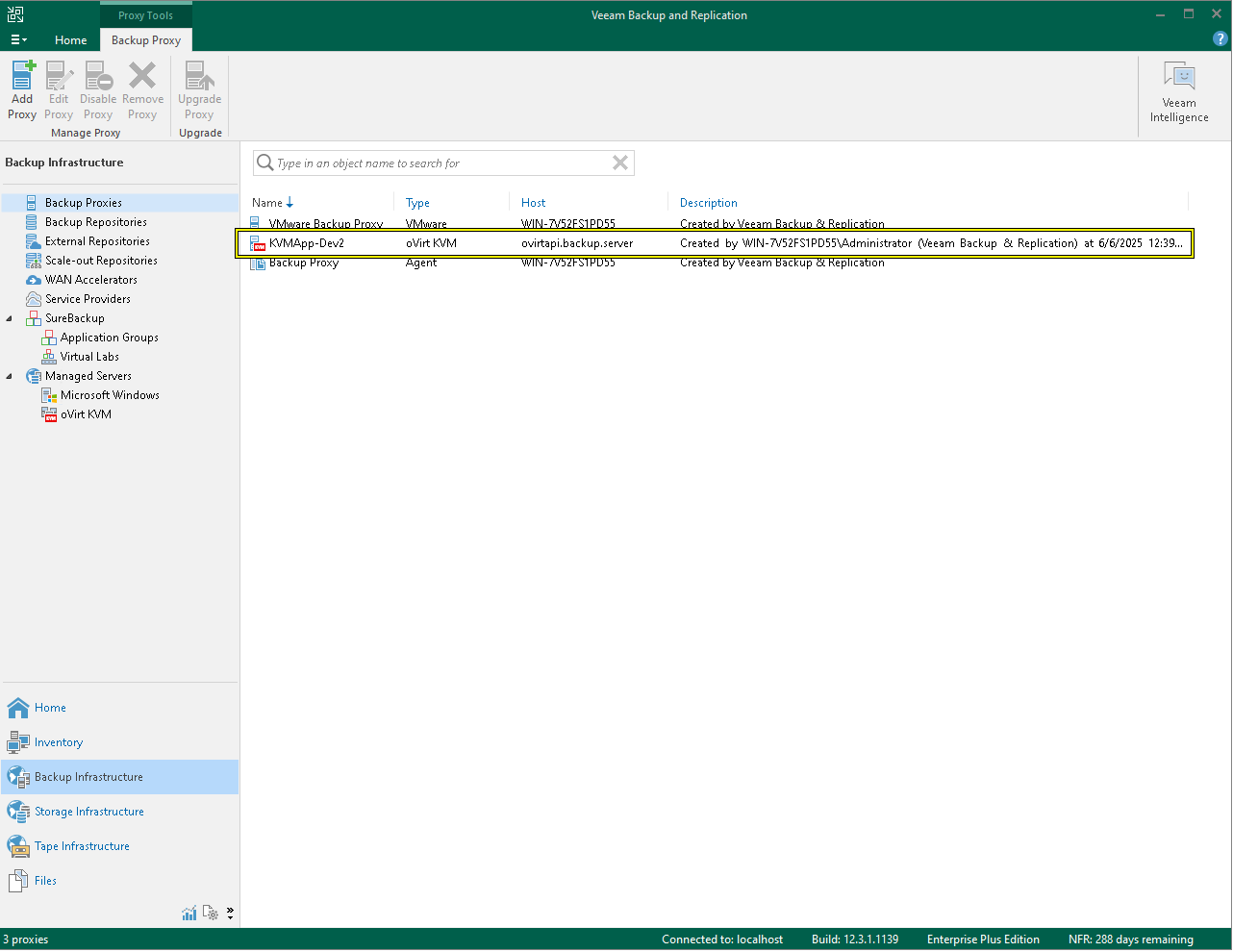
4.3 Verification
If everything is set properly, you should be able to see the available Virtual Machines in the Inventory tab under the Virtual Infrastructure -> oVirt KVM section.
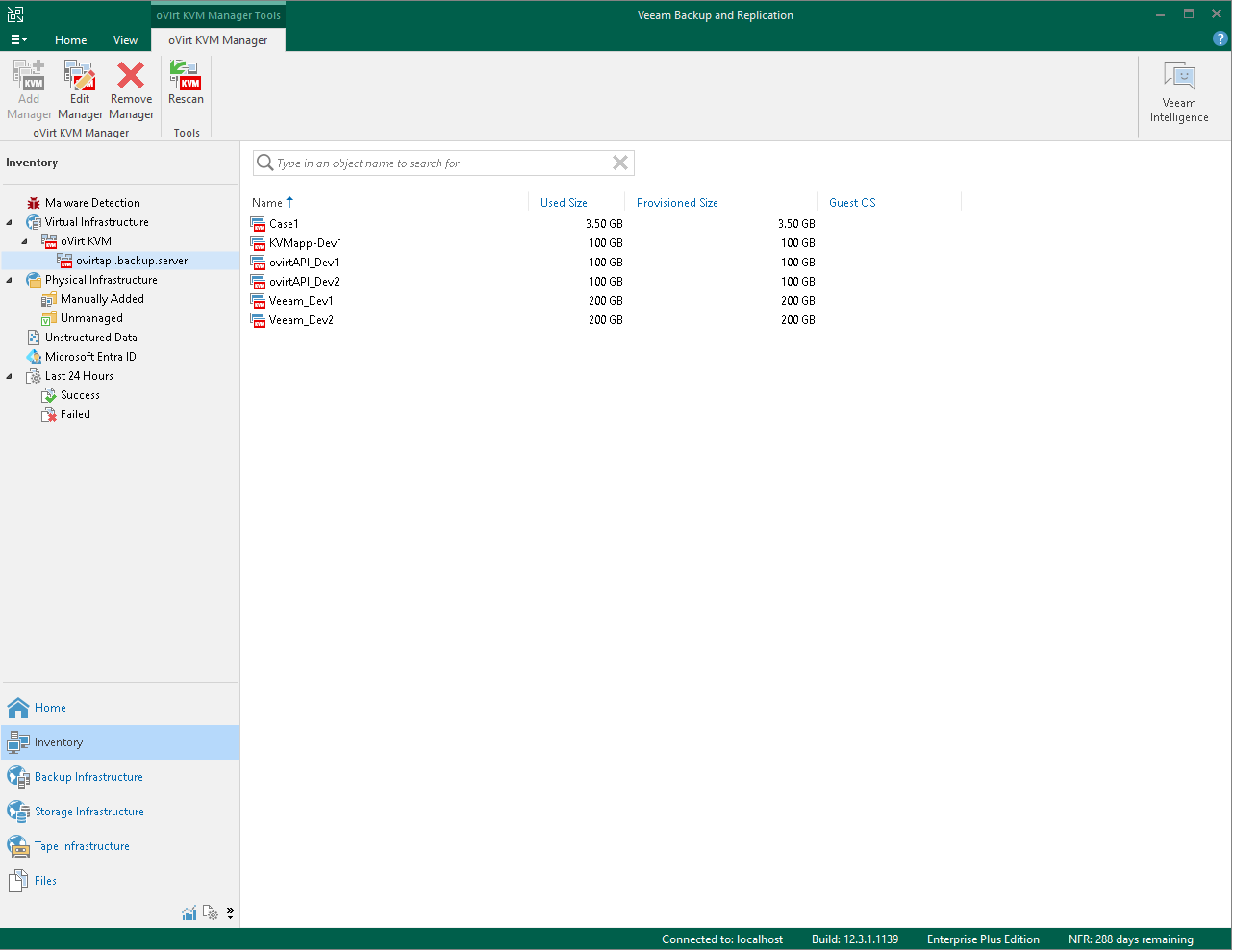
Logging information
The ovirtapi server will generate logs in the following directory depending on the operating system used:
- Ubuntu/Debian:
/var/log/apache2 - Alma/RHEL:
/var/log/httpd
If you use the cleanup script provided at /usr/lib/one/ovirtapi-server/scripts/backup_clean.rb, the cleanup logs will be placed at /var/log/one/backup_cleaner_script.log.
Volatile disk backups
To perform a backup of volatile disks, enable this functionality in the OpenNebula virtual machine configuration by setting the BACKUP_VOLATILE parameter to YES, otherwise the disk won’t be listed in Veeam. For more information regarding backups of volatile disks in OpenNebula please refer to the backup documentation page.
We value your feedback
Was this information helpful?
Glad to hear it
Sorry to hear that